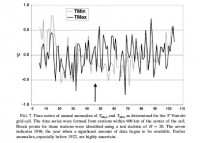By John Christy, William B. Norris, and Richard T. McNider, Journal of Climate
The observation that the trends of TMax and TMin are different in many locations around the world has been documented in several sources (e.g., Easterling et al. 1997) though when globally averaged, the difference seems to have been decreasing in the most recent two decades (Vose et al. 2005), unlike our results for East Africa. The implication of our reconstruction for East Africa, north Alabama (Christy 2002), and central California (Christy et al. 2006) support the lack of positive trends in TMax, and thus the possibility that these truly indicate the nature of changes in the deep troposphere.
The fact that the difference in trends in TMax and TMin continues, and in fact accelerates, in the period of 1979–2004 in East Africa may be important in interpreting the results of Vose et al. (2005). While it is possible that East Africa difference trends are indeed different than that of the globe as provided by Vose et al. (2005), there is concern that the reduced number of stations in the 1979-2004 GHCN dataset may not be sampling many of the areas of the globe that are behaving like East Africa. Thus, it is important that the GHCN dataset be expanded to include more stations distributed around the globe.
The noticeable difference in trends of TMax and TMin implies that daytime and nighttime temperatures are responding differently to environmental factors.

Larger image here.
Changes in the surface characteristics and the boundary layer atmospheric constituents may be responsible for the relatively recent and rapid rise in TMin. There appears to be little change in East Africa’s TMax, and if TMax is a suitable proxy for climate changes affecting the deep atmosphere, there has been little impact in the past half-century.
The investigation of the surface temperature record as an indicator of human-induced climate change involves understanding the complex behavior of boundary layer processes (where surface temperatures are actually measured) and how temperatures within it are affected by the numerous changes that occur. This is an area of research open for considerable inquiry because it raises new questions concerning the types of data indices now used to detect climate change. At the least, the time series of both TMax and TMin should become separate variables to be studied for long-term changes.




